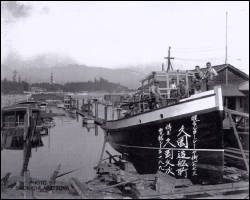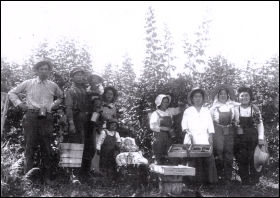|
This, in turn, led to the declaration of a Gentlemen's Agreement
between the governments of Canada and Japan, limiting the number
of immigrants to less than 400 annually. The agreement was revised
in 1923 and again in 1928, further reducing the allowable number
of immigrants.
Legal restrictions limiting the range of allowable occupations
compelled the immigrants to seek work in a few ventures, such as
sawmills, farming, fishing, coal mines and rail construction. The
immigrants, predominantly unmarried males, sent back to Japan for
picture brides and made their homes in Vancouver and other coastal
communities until the outbreak of the Pacific War.
When the Consulate opened in 1889, the main import products from
Japan were tea and silk. The silk trade particularly benefited from
Canadian Pacific’s trans-continental rail links, with the product
ultimately unloaded in New York for processing into saleable items.
Mandarin oranges also enjoy a long history, the first shipment
from Japan arriving in Vancouver in 1891. Over the century, the
oranges have acquired a festive quality about them and have become
synonymous with the advent of Christmas.
Exports from Canada - mainly lumber, coal, wheat and marine products
- increased tenfold from 1900 to 1910. These export products of
the turn of the century still constitute an important part of Canada’s
trade with Japan.
At the outbreak of the Pacific War, the Japanese Canadian population
was an estimated 23,000 persons. About 96% of the total lived in
the coastal region of B.C., with the largest concentrations found
in Vancouver and the fishing village of Steveston.
Consul Ichiro Kawasaki, interviewed by the Vancouver Sun and Daily
Province on December 7, 1941, showed deep concern for the well-being
of Japanese Canadians. He told the papers that he hoped that Canadians
would be kind enough and broad-minded enough to let naturalized
Japanese in the Dominion live in peace. He also stressed that Japanese
Canadians could be expected to remain loyal to Canada.
>>>1942-1987
|
|
 |
|

Hisaoki Boat Shop, c. 1920
(Photo courtesy: Japanese Canadian National
Museum. Photograph number: JCNM 92/20.002, Shokichi Akatsuka fond)

Raspberry Pickers at Hatzic Farm, c. 1935
(Photo courtesy: Japanese Canadian National
Museum. Photograph number: JCNM 97/189.1.224, Steve (Yoshio) Shikaze
fond)
|